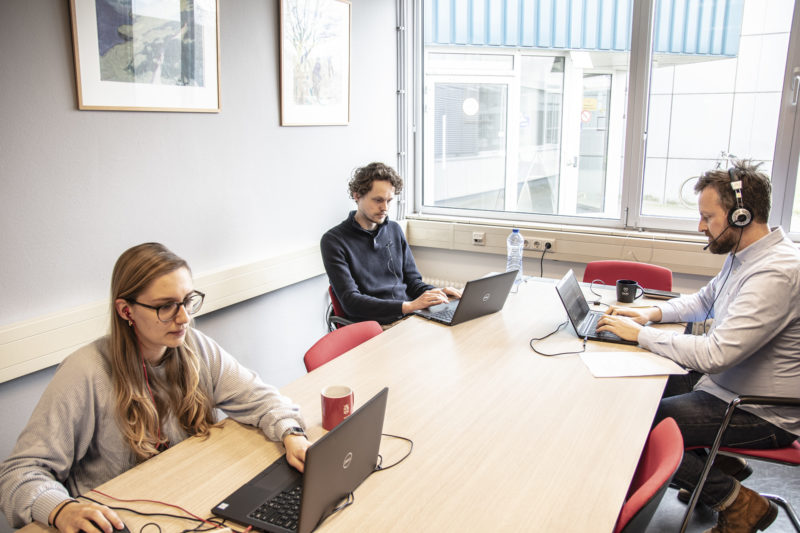
Behind the scenes at the CIT
These people put the uni online
Two cleaners are walking across the practically deserted square in front of the Mercator building. In the distance, you can hear the Feringa building being constructed. Only six bicycles are parked in the myriad of available racks. There are only four cars in the car park out back.
Nevertheless, there are fifty lecturers visiting the building today. They just happen to be digital. They’re all taking the webinar about online teaching. The three people organising the lesson are, interestingly enough, not quarantined at home. Instead, they’re sitting around a large table in the Mercator building, at appropriate distances from each other. They each have their own mug and their own laptop. One of them is wearing headphones with an attached mic.
‘Welcome everybody, from a very quiet Zernike campus’, Rick Huizinga says. The educational expert, who has a remarkably smooth voice, will be teaching a webinar on Collaborate, the programme the UG uses for online classes.
‘He sounds like Bob Ross’, Nestor expert Rob Eekhout jokes. He’ll be the man behind the scenes today. Huizinga joins in on the joke. ‘Whenever I want to make sure that people are actually listening, I tell them to get a little blue paint on their brush.’ He laughs. Yasmin de Groot, a Nestor student assistant who today will be answering any questions the lecturers might have, laughs as well.
Hectic week
The mood in the room is cheerful, and Huizinga’s soothing voice makes it sound like nothing out of the ordinary is going on. That is obviously not the case here. Less than a week ago, hundreds of lecturers and thousands of students had their lives interrupted. Now, they’ve had to radically change the way they work and study.
Huizinga is glad he and his colleagues can get together in person during this first, hectic, week. It simply makes discussing things easier, he says. It’s only temporary, though, just to get everyone started, Eekhout expects. ‘I can imagine we’ll be doing this from home soon enough.’
On Sunday, I spent seventeen hours making all the slides
The three take turns working at the Educational Support and Innovation department, switching with other employees at the Center for Information Technology; if one of them gets ill, someone else can take over for them.
Tracy Poelzer kicked off the first webinar on the Monday after the university cancelled all classes for the next three weeks. She worked the entire weekend. ‘On Sunday, I spent seventeen hours making all the slides.’

Thousands of meetings
That first time, 160 lecturers showed up for the live lessons. This time, it’s fifty. Lecturers can also watch the lessons later.
Department head Louwarnoud van der Duim says it immediately took off. He points to a graph on his screen which shows how many people are using Collaborate. On Sunday, March 15, it was only used fifty times. ‘That’s mainly us, when we were still testing it’, says Van der Duim. The next day, the programme was being used three thousand times, and the number only went up in the days after that.
Google Meet also saw a lot of use. Meet is the app the UG uses for online meetings. There had been 1,228 sessions in February, but in the three weeks since, that’s increased to 26,388: five to six thousand meetings a day.
Fits and starts
In other words, a lot of people are working online. They have no choice, since it was recently announced that the university will stay closed until the end of the academic year. Even the most computer-illiterate people have to figure it out.
Obviously, the transition is happening in fits and starts. ‘We’re building the plane as we’re flying it’, says Poelzer. Huizinga emphasises this bit of wisdom during the webinar as well: everyone is doing the best they can.
I’m very proud of how proactive our lecturers have been
That goes for elsewhere at the CIT, too. In total, 260 people are working behind the scenes to make sure that all those people working from home can go online, says CIT director Ronald Stolk. The server capacity normally allocated to the digital tests in the Aletta Jacobs hall is now being used to allow people to work from home.
The lecturers appreciate all the work the department is doing. ‘We’ve had a lot of positive reactions in the webinars and on Twitter’, says Stolk. ‘I’m really proud of how proactive our lecturers have been.’
Technical issues
Back to the webinar. Huizinga tells the lecturers they should try to get their students online fifteen minutes before the class actually starts. ‘Otherwise, the first ten minutes of your class are lost to students suffering technical issues. They usually solve themselves as the students figure out how everything works.’
Another tip: there are plenty of other applications to use beside Collaborate and Meet, like Zoom, Facetime, Skype, etc. There are plenty of options. ‘Except we don’t provide support for any of those’, says Huizinga. ‘If you have any issues, we can’t help you.’ Poelzer explains: ‘We want to get it right.’
Students usually figure out how everything works
Huizinga’s smooth voice tells the lecturers it’s best to turn the chat sounds in the application off. ‘You’ll hear an endless stream of beeps as students say hi to each other and send emojis.’
Student assistant Yasmin coughs into her elbow before continuing to type an answer to a lecturer. This is how the three show the participants around their new classroom. Here, they’re not just teachers, but concierges, secretaries, security guards, and teaching assistants.
Big change
‘It’s been a big change for us all’, says Poelzer. She had seen the university’s lockdown coming. ‘A friend of mine in Beijing teaches high school. They’ve been shut down for seven weeks.’ Her friend showed her how they handled things over there.
Now that so many lecturers are training to teach online, they might be able to work like this more often after the pandemic is over. ‘We used to cancel classes when lecturers were away at a conference or something’, says Yasmin. ‘But in the future, we’ll be able to record the class beforehand.’
There is a but, says Huizinga; what they’re doing now doesn’t even come close to regular classes. ‘Making online classes as good as physical classes would take eighteen months of work. We’re in survival mode right now. Sure, it’s convenient for when a lecturer isn’t available, but it won’t fundamentally change how we teach.’
Online exams
The next problem has also already presented itself: the exams. ‘We have a list with guidelines from the exam committees’, says Van der Duim. He and his colleagues have to find out how much on that wish list is actually feasible.
‘There are options’, he says. ‘Some faculties already have take-home exams.’ In a take-home exam, students have to write a paper instead of answering essay questions on an exam. ‘We’ll scan the papers for plagiarism’, Van der Duim explains. Or, the exams with essay questions are administered online.
I’d be worried if this was permanent
Isn’t there a greater risk of fraud? He acknowledges that there is. ‘But we’ve got ways to sniff that out. If a student who usually gets low grades suddenly scores really high, we might do an oral exam to make sure they actually studied.’ He knows it’s not ideal. ‘But needs must.’
In the end, it’s up to the lecturers and the exam committees to decide what’s acceptable, he emphasises. ‘I’d be worried if this was a permanent way of doing things’, says Van der Duim. ‘But it’s temporary.’
A tip from Poelzer in these times of social isolation: organise a CollaBARate session with your colleagues, like Wander Jager with the University College Groningen. Have a drink together from behind your computer screens.

